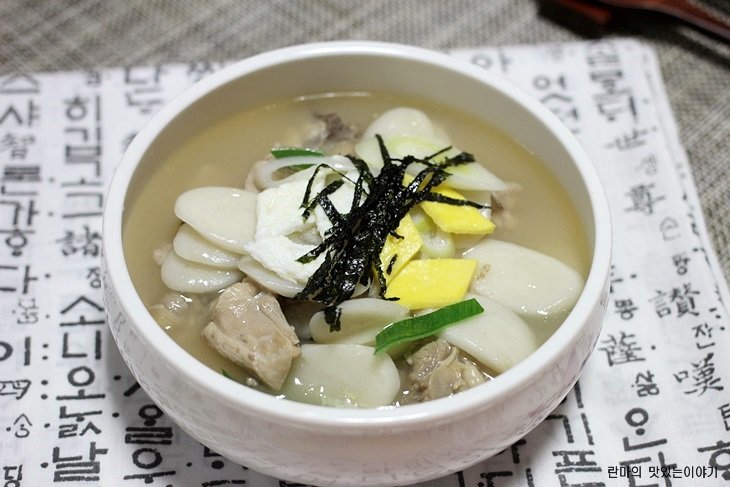Does what you’re eating mean what you think it means?
‘Janchi guksu’ noodles for a long and happy life
Noodles in Korea have come to symbolize longevity and good health. For this reason, a type of noodle soup called ‘janchi guksu’ is traditionally eaten on wedding days in Korea, as a good-luck gesture for the new couple.
The word ‘janchi’ literally means ‘banquet’, because this popular Korean good-luck noodle soup was usually reserved for special meals. These days, janchi guksu is eaten anytime, but you will almost always find it served at wedding ceremonies. Look out for this dish next time you’re at a Korean wedding! Janchi Guksu is made using wheat-flour noodles in an anchovy-based, hot broth, topped with various fresh vegetables. If you’d like to make some yourself to with a friend or loved one good luck, check out this recipe here.
Samgyetang to cool down on ‘boknal’
It might seem counter-intuitive to consume a boiling-hot bowl of chicken soup on the hottest day of the year, but this is exactly what Korean tradition dictates that you do! On ‘Boknal’ – or the three ‘hottest days of the year’ according to the Korean lunar calendar – you will find long lines outside popular samgyetang restaurants in Korea.
Traditional Korean medicinal practice taught that samgyetang heated the body from the inside out, and was thus the best way to help expel excess heat from the body. This belief was also called ‘Yi Yeol Chi Yeol’, or ‘relieving heat with heat’. Much Eastern medicine teaches that it’s better to counteract heatstroke with warm foods and liquids, rather than anything too icy cold.
Become one year older with ‘tteokguk’
Since the late 1700s, tteokguk – or rice cake soup – has been eaten on the lunar new year, as a way of symbolizing gaining a year of life, or becoming ‘one year older’. Indeed, one way of sweetly asking someone’s age was to ask them how many bowls of tteokguk they had eaten!
Tteokguk contains oval-shaped slices of soft, chewy rice cake in a meaty broth. The long tubes of rice cake before it is cut traditionally symbolized prosperity (much like noodles), while the oval shaped slices are thought to represent a coin, also helping bring wealth in the new year. Recently, many Koreans have also come to eat tteogkuk on the solar new year, January 1st, too. To make your own tteokguk this lunar new year, check out this recipe.

Chase away bad spirits with ‘patjuk’
Red bean porridge, or ‘patjuk’, has been eaten for many years on winter solstice as a way of driving out bad spirits and bring in health and happiness. Patjuk is a seasonal dish, with the red beans used usually from the recent fall harvest.
You can find out more about patjuk and winter solstice on our recent blog post, here.
Pass your exams with ‘yeot’
‘Yeot’ is a kind of traditional Korean candy, often compared to toffee or taffy, made using hardened syrup. Yeot is traditionally thought to bring good luck before exams. The Korean word for ‘stick’ is much like the word for ‘to pass a test’, and the stickiness of yeot is thought to help students literally ‘stick’ to their studies and their goals.
For this reason, sales of yeot soar through the roof each year before the national college entrance exams, as parents and family members of high school students buy the candy as a good-luck token.
The phrase ‘eat yeot’, however, has also come to be a commonly used insult. Indeed, the 2014 Korea world cup football team – who were eliminated from the tournament without a single win for the first time in 16 years – had yeot thrown at them upon their return to Korea by angry football fans shouting ‘eat yeot!’.
Ensure a healthy year ahead by chewing on ‘bureom’
‘Bureom’ is a collection of nuts, including walnuts, pine nuts, chesnuts, peanuts, and gingko nuts, traditionally gifted on Korean traditional holidays, especially the first full moon day of the lunar calendar (usually 15th days after the lunar new year, Seollnal).
Cracking the nuts open with your teeth is thought to represent good health (and presumably, strong teeth!)
You’ll find specially packed boxes of bureom selling for high prices in marts across the country right before lunar new year.
Recover after giving birth with ‘miyeokguk’
Miyeokguk, or seaweed soup, is fed to new mothers two or three times a day for up to a month after giving birth, to replenish nutrients lost during childbirth. This belief certainly has some medicinal truth to it, as the seaweed in miyeokguk is packed full of calcium and iodine – both very important nutrients for nursing mothers.
As miyeokguk is a symbol of birth, and also the first food eaten by a new mother, it has also come to be seen as a birthday food. Many Korean parents will make miyeokguk for their children on their birthdays to celebrate.
Increase your stamina with ‘bokbunja’
Bokbunja is a kind of red berry wine native to Korea. Although purported these days to have many antioxidant and other health benefits, it was traditionally popular thanks to the belief that it helped invigorate ones’ libido and increase stamina!
The word ‘bokbunja’ comes from the Chinese hanja characters meaning ‘flip’, ‘pot’ and ‘person’. Ancient myth tells the story of a bokbunja berry farmer who found the fruit to give him so much power, that he flipped his chamber pot over when relieving himself! We’re not sure how much truth there is to this tale, but it makes for a fun story all the same!
Learn more ins and outs of traditional Korean cuisine with a Gastro Tour Seoul, led by Veronica Kang – Korean local and long-time culinary expert. For more information, email info@gastrotourseoul.com or see here for a list of our upcoming tours in and around Seoul.
